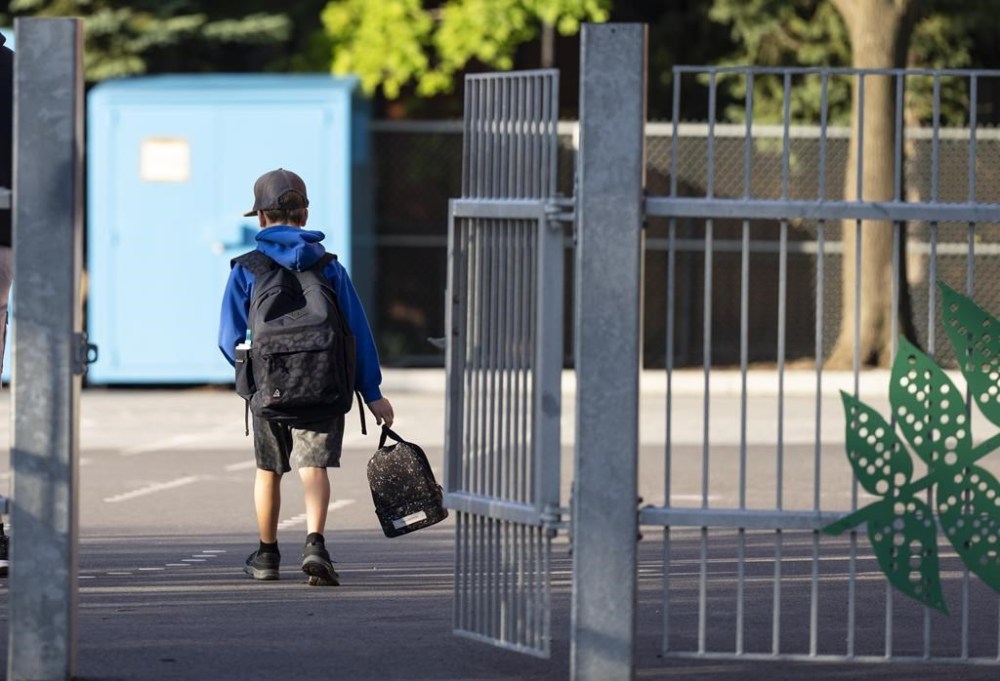Some Canadian students going back to school face heat wave, post-wildfire landscape
Advertisement
Read this article for free:
or
Already have an account? Log in here »
To continue reading, please subscribe:
Monthly Digital Subscription
$1 per week for 24 weeks*
- Enjoy unlimited reading on winnipegfreepress.com
- Read the E-Edition, our digital replica newspaper
- Access News Break, our award-winning app
- Play interactive puzzles
*Billed as $4.00 plus GST every four weeks. After 24 weeks, price increases to the regular rate of $19.00 plus GST every four weeks. Offer available to new and qualified returning subscribers only. Cancel any time.
Monthly Digital Subscription
$4.75/week*
- Enjoy unlimited reading on winnipegfreepress.com
- Read the E-Edition, our digital replica newspaper
- Access News Break, our award-winning app
- Play interactive puzzles
*Billed as $19 plus GST every four weeks. Cancel any time.
To continue reading, please subscribe:
Add Free Press access to your Brandon Sun subscription for only an additional
$1 for the first 4 weeks*
*Your next subscription payment will increase by $1.00 and you will be charged $16.99 plus GST for four weeks. After four weeks, your payment will increase to $23.99 plus GST every four weeks.
Read unlimited articles for free today:
or
Already have an account? Log in here »
Hey there, time traveller!
This article was published 05/09/2023 (780 days ago), so information in it may no longer be current.
TORONTO – When Alicia White accompanied her daughters to their first day of class on Tuesday morning, she saw for the first time how close wildfire flames came to their school in Kelowna, B.C.
It was the beginning of a new school year for many students across Canada, and while White said her kids experienced much of the same first-day jitters and excitement as always, the fire that tore through their community added a certain sombreness to the day.
“We did drive around the corner and saw the trees up on the hill — they’re just gone. And my youngest just said: ‘Oh, poor trees,'” White said.

The government of British Columbia has said no schools were damaged by the fires that tore through parts of the province, but White said her family is still anticipating a different sort of school year given that the forests outside the school used to serve as a secondary classroom.
Now, White said, the teachers will have to rethink how they use the land to teach their students.
For residents of Yellowknife, however, summer break has been extended.
Typically, students would have returned to their classrooms on Aug. 28, but the city is still under an evacuation order as fires continue to burn, so school will have to wait.
Climate also played a role in the return to school farther east, where heat warnings blanketed much of Central Canada.
One school board in Quebec closed all elementary and high schools on Tuesday due to the heat, while other districts in that province and Ontario said they would put measures in place to adapt to the high temperatures.
Quebec Education Minister Bernard Drainville, speaking to reporters at a high school inauguration in Gatineau, said Tuesday that the high temperatures — expected to reach 33 Celsius Tuesday with a humidex of 41 — were exceptional.
“I trust that teams in the schools will well manage the (heat) situation, I don’t have any doubt,” he said.
The province intends to build 150 new schools in the coming years, but they won’t be air conditioned.
“In newly built schools, we will install mechanical ventilation systems, which isn’t air conditioning but are ventilation systems that will provide for a certain level of comfort,” Drainville said.
In Ontario, the Toronto District School Board announced Monday evening that it, too, would put its heat plan in place as the mercury was expected to hit 34 degrees, with a humidex of 42.
The board says that of its 583 schools, only 177 are largely air conditioned. Another 243 have cooling centres in large areas such as the gym or library.
Aside from the heat, parents and teachers say they’re expecting a new crop of issues to affect classroom learning this year, including generative AI technology, affordability and climate change. For some students, however, the first day of school experience remains largely unchanged year after year.
“I want it to still be summer,” said nine-year-old Harrison Halliday, who’s entering Grade 5 with a healthy dose of apathy.
Harrison’s dad, Bill Halliday, was far more optimistic as he dropped his two sons off at their Toronto school this morning.
“The days will be spent without childminding and I’ll be able to work and not stress about what they’re doing and keeping them off screens,” Halliday said. “God, that’s going to be good. I think it’s good that they’re active and going to be with their friends again.”
Meanwhile, Sid and Mukta Kanasker and their daughter Kashvi said they were excited for her to enter the fourth grade, despite the typical nerves that come with the uncertainty of a new year.
“I think coming back after two months, of course, there is anxiety with which class she will go and how the new teacher would be,” Sid Kanasker said. “But I think the school is great.”
–With files from William Eltherington and Sidhartha Banerjee
This report by The Canadian Press was first published Sept. 5, 2023.


